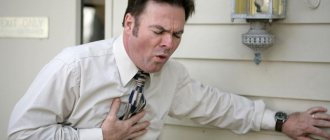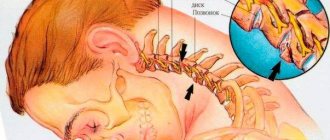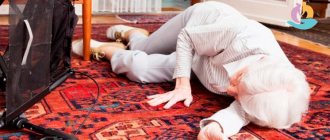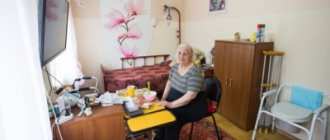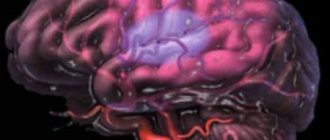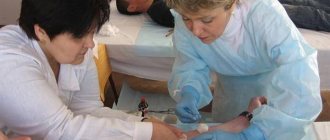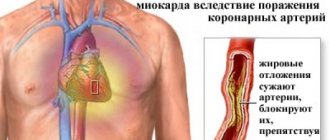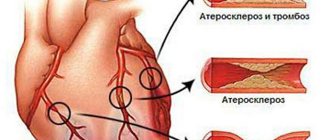Exogenous causes of shortness of breath
All causes of shortness of breath in older people when walking can be divided into two types - endogenous (arising as a result of the influence of internal factors), and exogenous (a consequence of the influence of external factors. Let us first consider the external factors that provoke the development of difficulty breathing:
- Increased physical stress on the body
. Appears as a result of insufficient training of the body and the inability of the respiratory and cardiovascular system to provide cells with proper oxygen nutrition. It may appear in older people during prolonged climbing of stairs, during long walks after prolonged inactivity.
Endogenous factors in the development of shortness of breath
There are many more internal factors and root causes for the development of apneustia. This is due to the fact that the phenomenon, in most cases, indicates the presence of a disease or pathology. As a rule, rapid and difficult breathing occurs in the following cases:
- Heart failure
. In diseases of the cardiovascular system, the heart does not cope well with its functions, and therefore is not able to fully circulate blood throughout the body. As a result, hypoxia begins, including in the lung tissue, resulting in difficulty breathing. According to statistics, women over the age of 60 are more likely to experience this type of dyspnea than men.
Based on the total number of factors that provoke the appearance of apneustia, we can conclude: this phenomenon has a developed cause-and-effect relationship, and is also a characteristic symptom for a whole group of diseases.
Treatment of shortness of breath in heart failure: how to relieve the symptom and what medications to take
Heart failure is always accompanied by shortness of breath. Even a healthy person experiences shortness of breath after intense exercise.
But in these cases it passes quickly, being a physiological reaction and not a pathology. But with heart failure, things are different. Even a small load brings serious inconvenience.
Let's look at what drug and traditional treatment is, how to get rid of shortness of breath, what to take and how to cure one of the symptoms of heart failure, what medications and preparations are used.
Treatment of shortness of breath with folk remedies
In order to eliminate dyspnea, doctors prescribe medications whose action is aimed at eliminating the root cause of the development of the symptom, as well as the phenomenon itself. These can be strong drugs, tablets and sprays designed to relieve heart failure, asthma, COPD, etc. But what to do if dyspnea appears only as a result of increased physical, psychological stress or another reason not related to diseases? In this case, the causes of shortness of breath when walking can be treated with folk remedies.
The following recipes are the most popular:
- 1 liter of liquid honey is mixed with 10 crushed heads of garlic and freshly squeezed juice from 10 lemons. The finished mixture is infused for 7-10 days. The finished tincture is taken 4 times a day, the course continues for a month.
Treatment with traditional medicine, especially for older people, should be carried out with caution, and therefore consultation with a doctor is mandatory to adjust treatment.
There are other traditional medicine recipes that are effective in treating shortness of breath. We invite our readers to suggest in the comments their own recipes that have helped eliminate the phenomenon of dyspnea.
Treatment of patients with shortness of breath
If an elderly patient experiences or worsens shortness of breath when walking, doctors prescribe treatment depending on the cause of the respiratory dysfunction. When treating shortness of breath that occurs or worsens during emotional stress, psychotherapists use an integrated approach using psychotherapeutic, medicinal, and physiotherapeutic techniques and measures.
If elderly people have shortness of breath caused by anemia, therapists provide individually selected therapy. When the hemoglobin level is 109-90 g/l, hematocrit 27-32%, a diet is prescribed, including iron-rich foods, salts, polysaccharide compounds of divalent iron, iron (III)-hydroxide polymaltose complex. If the hemoglobin level is below 90 g/l, the hematocrit is below 27%, a hematologist is consulted, and salt or polysaccharide compounds of divalent iron or iron (III)-hydroxide polymaltose complex are prescribed in a standard dosage. In addition to previous therapy, iron (III)-hydroxide polymaltose complex or iron III dextran is administered intravenously. Patients with severe anemic and circulatory-hypoxic syndromes are given infusions of leukofiltered erythrocyte suspension.
If the cause of severe shortness of breath when walking is heart failure, the following medications are prescribed:
- Angiotensin-converting enzyme inhibitors;
- β-blockers;
- Aldosterone receptor antagonists;
- Diuretics;
- Cardiac glycosides;
- Angiotensin II receptor antagonists.
Patients whose cause of shortness of breath, which worsens when walking, is bronchial asthma, are prescribed drugs that dilate the bronchi by reducing the tone of the smooth muscles of the bronchi, and improve bronchial patency by reducing inflammation of the airway wall.
If you are concerned about severe shortness of breath and palpitations when walking, make an appointment with a therapist online or by calling the contact center. After determining the cause of shortness of breath, the doctor will individually select the most effective drugs to restore respiratory function.
Author
Alexander Vyacheslavovich Averyanov
Pulmonologist, MD, professor
How to cope with shortness of breath in old age
Hello, dear readers! Many people often experience shortness of breath as they age. In this case, nutrients and oxygen are difficult to deliver to the heart, which causes great harm to the body. Treatment of shortness of breath in older people should be taken under control: at the initial stage, it is easier to find and eliminate the cause than when the disease becomes irreversible.
What is shortness of breath
In medicine, shortness of breath is called dyspnea or apneustia. At the same time, the frequency and depth of breathing changes.
- burning in the lungs;
- increased breathing.
It may be difficult for a person to inhale (inspiratory type) or exhale (expiratory type). More common is the combined type, when it is difficult to both inhale and exhale.
The mechanism of occurrence is as follows:
- since the lungs do not saturate the blood fully, tissues and organs experience oxygen starvation;
- the brain sends a signal to increase breathing in order to get rid of this condition and gain a double supply of air.
Why is this happening? There are two groups of reasons:
- Exogenous - due to external influences. Factors include excessive physical or psycho-emotional stress for the body, improper medication use, and bad habits.
- Endogenous - as a result of internal pathologies. Among them are heart failure (HF), ischemia (CHD), bronchial asthma, lung diseases, and anemia.
Only after determining the cause will the doctor prescribe treatment.
Shortness of breath is not an independent disease, but just a symptom of another pathology.
Therefore, the following types of shortness of breath are distinguished:
- pulmonary (for pneumonia, pleurisy, poisoning);
- cardiac (with heart failure, including in chronic form);
- cerebral (for injuries, tumors, edema, hemorrhages, infections);
- hematogenous (for anemia, acidosis, diabetic coma).
Conventionally, the last group includes intoxication with alcohol-containing liquids, tobacco, and drugs.
Folk remedies for illness
Patients often try to be treated with folk remedies. This is widespread, as breathing problems can last for years, being painful and with a noticeable decrease in quality of life.
Since most pharmaceutical drugs are made based on the medicinal properties of plants, why not try preparing the medicine at home.
But before you drink anything for shortness of breath and heart failure, you should definitely consult your doctor.
Some home remedies actually help (temporarily):
- Licorice roots, mint and yarrow are great for making your own medicine.
- Aloe leaves infused with vodka quickly eliminate any cough and shortness of breath. Take a teaspoon of infusion, then a tablespoon of honey and after a ten-minute pause, drink a glass of tea. The reason remains, the disease continues to progress and you will still have to start traditional treatment. You can't do it without the help of doctors.
- Cranberry herb, which is brewed and drunk like tea, helps a lot.
- You can get rid of cardiac shortness of breath with the help of motherwort tincture.
When should you see a doctor and which one?
If you have shortness of breath, you need to visit a GP. If necessary, he will schedule consultations with more specialized specialists - a cardiologist, pulmonologist, hematologist, rheumatologist, allergist-immunologist, phthisiatrician, neurologist, oncologist, endocrinologist, infectious disease specialist.
They will pay attention to a number of additional signs to distinguish one disease from another:
- whether increased breathing is associated with physical activity or appears even at rest;
- does dyspnea occur suddenly if you take a horizontal position;
- are there additional sensations such as fear of death, chronic fatigue;
- Is shortness of breath accompanied by increased blood pressure, blue lips, cough, swelling, pain when urinating.
Additional examinations are prescribed:
- ECG, Holter monitoring, ultrasound, x-ray, coronagraphy, scintigraphy;
- tests for biochemistry, coagulogram, general urine test, etc.
This is still far from a complete list.
Heart failure in the elderly: symptoms and treatment
Heart failure is a pathological condition in which the heart is unable to cope with the volume of blood that the body needs. The heart works, as before, to the maximum, but is not able to supply all organs with blood.
This is an acute or chronic disorder of the heart in an elderly person. HF entails insufficient blood supply to organs and tissues. The root cause of this condition is the deterioration of the heart’s ability to fully fill and empty due to damage to the myocardium. This is a common problem among older people.
- Chronic deficiency develops over a long period of time and is characterized by the following symptoms: fatigue, shortness of breath, swelling, decreased physical activity, etc.
- Acute heart failure is caused by toxins, trauma, and heart disease. If left unattended, this condition can lead to death.
Heart failure in the elderly is usually a symptom of other heart diseases: coronary artery disease, hypertension, heart attack, etc. HF does not occur on its own.
Also, according to specialists at the Dacha boarding house in Murino, other factors can influence the development of heart failure in old age: decreased blood supply to the brain, sclerosis, decreased lung volume, changes in blood circulation, and a decrease in stroke volume of the heart. A boarding house in Len will help you identify all these ailments in a timely manner. region for the elderly.
The reasons may be different:
- Heart defect – congenital or acquired;
- Tumors;
- Ischemia;
- Cardiosclerosis;
- Chronic angina;
- Infectious diseases;
- Chronical bronchitis;
- Diabetes;
- Rheumatism;
- Hormonal disorders;
- Nervous tension;
- Physical overload;
- Stress;
- Circulatory disorders;
- Anemia;
- Arrhythmia;
- Thyroid problems;
- Tachycardia;
- Excessive use of medications, taking inappropriate medications;
- Underweight or overweight;
- Unhealthy diet;
- Bad habits.
In addition to dividing into chronic and acute, heart failure can be classified according to other criteria.
Chronic failure is divided into 4 classes:
- Class 1: a person has no complaints about poor condition, but signs of cardiac pathology are already present. The diagnosis is made after tests and research. They check cardiac function with and without stress on the body.
- Grade 2: fatigue, difficulty breathing, fatigue from any activity, even simple ones, appear.
- Class 3: characterized by palpitations, shortness of breath, fatigue due to simple physical activities. There are no complaints in a state of rest.
- Grade 4: constant discomfort is felt, even in a resting situation. With any load the patient gets worse.
According to localization, heart failure is divided into:
- Left ventricular. Blood stagnates in the small circle, and not enough of it gets into the large circle.
- Right ventricular. Blood stagnates in the large circle, its quantity decreases in the small circle.
- Biventicular. This is a simultaneous pathology in both ventricles.
According to hemodynamics there are:
- Hypokinetic failure. The heart does not produce enough blood, which results in shock.
- Congestive failure. Venous blood will stagnate in a large circle, causing swelling of the lungs and limbs, and asthma.
According to provoking factors, heart failure can be divided into:
- Reloading. The heart experiences excessive stress, which disrupts natural blood flow.
- Myocardial. The walls of the heart are affected, and the systolic and diastolic functions of the heart are impaired.
- Mixed. Simultaneous combination of different factors.
The following symptoms indicate heart failure:
- Hurting cough. There may be sputum and blood clots;
- Difficulty breathing for various reasons, shortness of breath;
- Sleep problems;
- Pale skin with a bluish tone - this occurs due to insufficient blood circulation;
- Swelling – the body cannot cope with the removal of fluid;
- Chronic fatigue, inability to work and live in the usual healthy rhythm;
- Nervous tension, irritability, bad mood;
- Problems with brain activity;
- Confused consciousness, absent-mindedness, poor memory;
- Changes in diet: refusal of some foods, loss of appetite;
- Nausea and vomiting;
- Impaired renal function;
- Involuntary urination;
- Feeling of heaviness in the sternum.
A specialist can diagnose HF after an examination. To do this, he conducts a detailed survey, identifies symptoms of the disease, and offers stress tests. An elderly patient undergoes urine tests.
Various procedures are prescribed for detailed examination:
- Echocardiography (EchoCG) with Dopplerography. The procedure helps to identify the causes of the development of pathology.
- Radioisotope ventriculography. Allows you to evaluate the ability of the ventricles to contract and their capacity.
- Electrocardiography (ECG). It will help detect arrhythmia, hypertrophy, and signs of poor blood supply to the myocardium.
- X-ray. It can be used to detect blood stagnation in the small circle and enlargement of the right heart.
- Hormonal study. It can be used to isolate myocardial cells. If deviations from the norm are detected, a severe stage of the disease can be diagnosed.
Diagnosis of heart failure is recommended for people at risk even in the absence of symptoms of heart failure. Since heart failure develops against the background of certain diseases, its timely diagnosis in its infancy will allow prompt treatment to begin and improve the patient’s quality of life. With insufficiency, there are always associated problems that also need to be properly treated.
Acute heart failure can lead to heart attacks. Emergency care will help avoid serious complications. As first aid, you can do the following:
- First of all, call an ambulance.
- Provide access to oxygen: open windows, remove tight clothing.
- Place the patient in a semi-sitting position. You cannot completely lay a person down - pulmonary edema may worsen.
- Continuously check blood pressure.
- Place nitroglycerin under your tongue. Taking other medications before the ambulance arrives is prohibited.
- In case of cardiac arrest, perform artificial massage.
In case of a heart attack, help must be fast and effective: every minute counts. Complete rest is shown. Timely assistance can save an elderly person’s life.
Taking medications is the main method in the fight against heart failure. Medicines for each patient are individually selected by the attending doctor.
For the treatment of heart failure in the elderly, the following are most often prescribed:
- Drugs for dilation of blood vessels. They increase blood flow, which improves the condition of organs.
- Means that activate metabolic processes. These are medications with magnesium and potassium. Riboxin and Carnitine can also be prescribed.
- Diuretics. Torsemide and hydrochlorothiazide are most often prescribed. They help remove salts from the body, lower blood pressure, and activate processes that will help normalize blood circulation.
- Diuretics. Prescribed for increased swelling. They may prescribe Uregit, Hydrochlorothiazide.
- Glycosides. Herbal medicines. Helps speed up heart rate. Digoxin is most often prescribed.
- Drugs that stabilize angiotensin levels. Lisinopril or Captopril are most often prescribed.
To prescribe drugs and dosages, the individual situation of a person is taken into account: his general condition, the degree of development of the disease, the likelihood of life-threatening factors. In treatment, minimum dosages are recommended, which are increased if necessary.
In case of heart failure, it is important to follow certain principles of therapeutic nutrition.
The diet should include:
- Liquid – 1.5 liters per day;
- Fats in the diet – 50-70 g per day;
- Carbohydrates – 300-400 g per day (80-90 g in the form of confectionery or sugar);
- Foods rich in potassium. It is useful to eat seaweed, raisins, dried apricots;
- Products that cause an alkaline reaction: wholemeal bread, milk, cabbage, beets, bananas.
Diet No. 10 is recommended; in case of 2nd and 3rd degree circulatory disorders, diet 10a is prescribed.
In old age, it is important to follow the following nutritional rules:
- Food should be rich in proteins and vitamins and easily digestible.
- Limit the content of table salt. It retains fluid in the body, which increases the load on the heart and leads to edema. A healthy amount of salt is 1-3 g per day. In severe stages of the disease, salt is completely excluded from the diet.
- In case of obesity, caloric intake should be limited to 1900-2500 kcal. It is necessary to exclude fried, fatty foods and confectionery products with cream from the diet.
- When losing body weight, five high-calorie meals a day are recommended.
Traditional treatment in old age can be combined with traditional medicine. Before using any traditional recipe, you should consult your doctor. The following folk recipes cope with deficiency and related problems.
- Wormwood contains tauremzin, which improves blood circulation and has a positive effect on the cardiovascular, nervous and respiratory systems. For treatment, a decoction of wormwood is prescribed. Dry herb (30 g) pour 2 glasses of water and boil over low heat for 15 minutes. Cool slightly. Take 3 times a day, 150 ml. in one go.
- Calming collection. It will help reduce stress on the heart and cope with some symptoms. To prepare, mix peppermint, lemon balm, and valerian (3:4:3). A tablespoon of the collection should be steamed in boiling water (300 ml) and left for 20 minutes. Filter, take 0.5 cups in the morning and before bed.
- Viburnum decoction. Mash one tablespoon of viburnum until the juice appears, pour one glass of boiling water, add a couple of teaspoons. Infuse the decoction for an hour, then take 0.5 tbsp twice a day. The course of treatment is 1 month.
- Hawthorn decoction. Useful remedy for heart pain. Rinse 500 grams of ripe fruits and pour one liter of boiling water. Boil for 20 minutes over low heat. Strain, add 2/3 cups of sugar and honey. Mix everything thoroughly. Take 2 tbsp. l. every day before meals. The product should be stored in a cool place.
- Adonis decoction. Pour a couple of tablespoons of dried adonis into a glass of boiling water, transfer to a thermos, and leave for two hours. Strain and drink 50 ml. 3 times a day for two weeks.
- Provide proper nutrition. A low-calorie and healthy diet will help effectively fight early aging, which is beneficial for older people. The diet should be rich in vegetables and fruits.
- An hour before meals, it is useful to drink a glass of water, rosehip decoction or juice, and at night - a glass of kefir.
- Reduce the amount of salt to a minimum, it is better to replace sugar with honey.
- Take vitamins.
- Consume foods with easily digestible calcium: cheese, milk, fermented milk.
- Products must be subjected to high-quality culinary processing.
- Food should not be very hot or cold.
- Instead of addictive sleeping pills, it is better to drink warm milk, herbal decoctions, and Valocordin. They are more useful for older people.
- Monitor the intake of medications, as an elderly person may forget to take them.
If the disease is left unattended, it can lead to negative consequences: heart pain, infections, bleeding in the lungs, asthma, liver failure, etc. The worst outcome is death.
For this reason, it is necessary not only to treat heart failure at the very beginning, but also to think about prevention.
For older people, it is necessary to prevent the development of diseases that lead to heart failure and the factors influencing its occurrence. If symptoms have already appeared, you need to take measures that will prevent the progression of the disease in older people.
The following are recommended as preventive measures:
- Maintaining a healthy diet: limit intake of unhealthy foods, fats, sugar;
- Body weight control;
- Regular walks and therapeutic exercises. Moderate physical activity;
- Reduced salt intake;
- Rejection of bad habits;
- Taking medications prescribed by a doctor;
- Regular examination by a cardiologist;
- Use of suitable folk remedies.
Using this information, you can protect your elderly loved one from developing heart failure or provide them with quality treatment.
We will agree on the date and time of the visit with you in a telephone conversation.
Source: https://dacha-pansionats.ru/blog/serdechnaya-nedostatochnost-u-pozhilyh-simptomy-i-lechenie
First aid for sudden shortness of breath
If this condition appears unexpectedly, do not wait to make an appointment at the clinic. Emergency hospitalization will help here (most likely it is an acute form of cardiac asthma or pulmonary edema).
The algorithm before the brigade arrives is simple:
- First, open the window to let in fresh air, this is what your body needs.
- Then unfasten anything that is pinching your chest, making a full breath impossible.
- If an elderly person is lying down, sit him down if possible. The legs should not be at the same level as the heart.
- Next, place Nitroglycerin under your tongue.
Most likely, if breathing does not become free, doctors:
- Eufillin will be administered intramuscularly;
- will give Furosemide as a diuretic;
- bandage the limbs with a tourniquet to limit blood access to the heart;
- They will offer hospitalization and bed rest for 3 weeks.
Otherwise, wait for decisions from a therapist or cardiologist. They will prescribe appropriate medications. But remember that only an integrated approach with lifestyle changes will help.
Treatment of shortness of breath depending on the cause
Methods for treating shortness of breath can be symptomatic (if the causes are not clear) and etiological (aimed at eliminating the underlying disease).
- diuretics to relieve edema;
- ACE inhibitors to reduce the load on the heart and relieve spasms;
- β2-agonists to relieve asthma attacks;
- beta blockers to saturate cells with oxygen;
- glycosides to normalize metabolism and energy metabolism.
The tablets are taken under the supervision of a doctor and strictly according to the instructions.
Self-prescription is prohibited: many diseases of old age are treated in a complex manner, so overdose, intoxication, or neutralization of the effect of one drug by another is possible.
Classification of medications
Experts divide pills for heart failure into several groups depending on the mechanism of action and other features.
The most common groups of medications:
- ACE inhibitors.
- Cardiac glycosides.
- Diuretic medications.
- Beta blockers.
- Metabolic drugs.
- Nitrates.
- Sedative and sympathomimetic drugs.
- Antithrombotic drugs.
In the treatment of pathology, drugs from other groups are used. The treatment regimen is drawn up in each case individually.
Prevention
Use the following recommendations as preventive measures:
- give up smoking and other bad habits;
- treat diseases in a timely manner, preventing them from becoming chronic;
- Avoid stressful situations whenever possible;
- keep your weight under control;
- keep physically active;
- Don't forget about regular medical examinations.
Do not try to dramatically change your lifestyle (diet, habits) or increase physical activity. Remember to be systematic and regular in your actions. Let it be, for example, leisurely walks in the fresh air, but daily.
Shortness of breath in older people, what to do?
Dyspnea, the medical name for dyspnea, is a pathological process characterized by changes in the depth and frequency of breathing.
Characteristic signs of shortness of breath:
- Frequent and shallow breathing;
- Feeling of lack of air and suffocation;
- Noisy inhalations and exhalations may be accompanied by wheezing and whistling;
- Severe compression in the chest area.
Shortness of breath may not be a pathological process.
The appearance of shortness of breath in a healthy person is possible during physical exertion on an unprepared body, with a lack of oxygen (climbing mountains, a closed room with a high level of carbon dioxide).
Physiological shortness of breath in a healthy person is not constant; when the cause is eliminated, it goes away.
Training prepares the body for physical activity, and shortness of breath disappears; ventilating the room reduces the level of carbon dioxide, which also eliminates shortness of breath.
Features of the condition
Dyspnea is a violation of respiratory function, which is expressed in the following symptoms:
- inhalation and exhalation are not deep, superficial;
- The breathing rate is not calm, it is accelerated.
This change in respiratory movements occurs in response to a decrease in the supply of oxygen to the organs and tissues of the body. Shortness of breath can be felt only when inhaling, or only when exhaling, or be mixed. During an attack, a person feels short of air and may feel a constricted chest.
Causes of shortness of breath in the elderly
The cause of shortness of breath in older people is a manifestation of respiratory failure. those. it is not possible to provide the body with normal blood gas composition.
It manifests itself in diseases of the respiratory system, cardiovascular and central nervous system.
An elderly person has shortness of breath, what should you do?
First of all, consult a doctor; it may be a manifestation of a serious illness.
Shortness of breath in older people, signs of what conditions it may be:
- Increased physical stress on an untrained body, for example, shortness of breath when walking in the elderly occurs when climbing stairs on foot, and before that they only used the elevator, or long walks after a period of physical inactivity. In this case, spend more time on physical activity and it will pass;
- Shortness of breath with anemia, a characteristic sign of decreased hemoglobin, with this disease it will not go away on its own, special treatment is necessary;
- Emotional stress can also cause severe shortness of breath in an elderly person, anger, rage, fear, and anxiety. If strong negative emotions are repeated frequently, it is better to consult a specialist; perhaps these are panic attacks.
- Excess weight can also cause shortness of breath when walking in older people. In this case, the cure for shortness of breath in the elderly is weight loss, weight control and proper nutrition;
- A serious cause of severe shortness of breath in an elderly person may be pulmonary diseases, characterized by difficulty inhaling or exhaling; treatment can be carried out by a pulmonologist;
- Heart failure is characterized by the onset of the problem in a horizontal position and goes away with a sitting position. This is a serious symptom, you need to contact a cardiologist without delay;
- Cardiac asthma can cause shortness of breath for several hours, which can lead to pulmonary edema. In case of a prolonged attack, call an ambulance;
- One of the most dangerous shortness of breath is pulmonary thrombophlibia.
Signs: an attack of severe coughing, stabbing pain in the chest area, possible blueness of the face, there may be cramps in the calf muscles, swelling of the legs.
It is necessary to urgently consult a doctor, as there is a threat that the blood clot may suddenly move to the pulmonary artery and lead to death.
Classification of shortness of breath
Dyspnea is classified into the following subsections:
Already at an early stage of circulatory failure, the respiratory center is irritated, pulmonary ventilation increases, and shortness of breath appears due to physical exertion and food intake.
Physical activity
According to specialists at a boarding house for the elderly in St. Petersburg, exercise therapy, swimming, brisk walking, and regular walks are recommended for older people. Comfortable physical activity trains the lungs. It is also an excellent prevention of shortness of breath.
Breathing exercises are indicated, during which the patient breathes with his stomach. To breathe properly, you need to inhale through your nose and exhale through your mouth. For correct execution, training and practice are required. During breathing exercises, air penetrates the lower thoracic region and fills the lungs.
Why shortness of breath appears when walking - the main reasons
The culprits of shortness of breath can be various diseases - they can be determined by the frequency and nature of inhalations and exhalations. Each category of pathology has its own name and rationale. In medicine, there is a division that is defined as central dyspnea, pulmonary, cardiac and hematogenous. In turn, they are also divided into several more types.
Pulmonary dyspnea
This category of pathology combines causes associated with lung diseases.
Expiratory dyspnea is the most common form, which is determined by difficulty in exhaling and occurs when the lumen in the bronchi narrows due to their swelling, spasm or blockage with mucus. To cope with this problem during breathing, you have to strengthen the work of the respiratory muscles, but this is not enough, and the exhalation cycle can be difficult.
This form of shortness of breath manifests itself in bronchial asthma, especially during attacks, as well as in chronic bronchitis, when bronchospasm occurs and allergic edema of the bronchi. This form is characterized by whistling and wheezing sounds when exhaling, but, unlike cardiac dyspnea, a person is able to sleep peacefully at night without experiencing suffocation, and his limbs do not get cold.
Inspiratory dyspnea is defined by difficulty in breathing. This occurs due to the accumulation of fluid in the chest - with fibrosis, lymphogenous carcinomatosis, pleurisy, ascites, and ankylosing spondylitis. A similar form also appears with swelling of the larynx and tumor diseases of this area.
This type of shortness of breath can be determined by a person’s inability to speak without taking frequent breaths; it also manifests itself during even minimal physical activity. Inhalation in such cases is accompanied by a whistling noise.
Cardiac dyspnea
The causes of this category of respiratory failure are most often mitral stenosis, left atrial myxoma or left ventricular heart failure, in which blood circulation is impaired, which leads to respiratory distress. Signs of cardiac dyspnea in these pathologies are orthopnea and polypnea.
- Orthopnea is a syndrome of cardiac shortness of breath that forces a person to remain in an upright position all the time, as this alleviates his condition. Orthopnea is associated with left ventricular and left atrial failure.
- Polypnea - characterized by increased frequency and depth of breathing, up to the phenomenon of hyperventilation of the lungs. Most often caused by excess venous blood flow to the heart when a person sits in a horizontal position, it can be caused by chronic heart failure.
Hematogenous dyspnea
Such shortness of breath occurs when toxic products appear in the blood due to liver failure, diabetes mellitus or poisoning. Due to the large air flow, breathing becomes noisy and clearly audible.
In addition, the hemic type differs, which mainly occurs during anemia, due to a decrease in the concentration of oxygen in the blood. In patients with anemia, the appearance of such shortness of breath is often a consequence not of the disease itself, but of other causes, for example, anemic myocardiography, hypoxic damage to the central nervous system.
Central dyspnea
This species is a symptom of pathological processes in the respiratory center of the central nervous system, with its original lesions, neuroses or from exposure to neurotropic toxic substances. Unlike all other categories, such shortness of breath is not a reaction of the respiratory apparatus to pathology in other organs; it itself is the root cause of respiratory failure, leading to serious consequences. It can manifest itself in different ways: arrhythmia, centrogenic bradypnea, hyperpnea, tachypnea and oligopnea.
- Respiratory arrhythmias are caused by dysfunctions in the brain stem, which occur with traumatic brain injury, stroke, inflammatory processes and edema, as well as with certain types of chemical or drug poisoning.
- Bradypnea is the name given to rare breathing that can occur due to drug poisoning or pathological changes in the central nervous system. Sometimes you can notice it in healthy people during deep sleep. If bradypnea occurs systematically, a consultation with a neurologist is required.
- Oligopnea is shallow, rare breathing with insufficient ventilation of the lungs; it can occur with hypothermia. If medical measures are not taken, this type of shortness of breath becomes more severe and can lead to respiratory arrest. In all cases, the prognosis for the appearance of oligopnea is unfavorable, as it leads to respiratory acidosis or diffuse cyanosis.
- Tachypnea is rapid shallow breathing that can occur with neuroses, tumor formations, and meningitis. The breathing rate reaches 75-80 times per minute. This phenomenon also occurs with pericholecystitis, diffuse peritonitis, ascites, and disruption of the central nervous system.
- Hyperpnea is pathologically frequent deep breathing that occurs in a comatose state with hemorrhagic stroke, meningitis, head injuries, and alcoholic coma. Due to the accumulation of mucus in the nasopharynx and trachea and the contraction of the pharyngeal muscles during breathing, snoring and whistling sounds often occur.
How to treat shortness of breath in heart failure?
Even a completely healthy person periodically feels a lack of air.
Typically, this feeling occurs during long runs and other cardio exercises, as well as due to nervousness. This is a natural reaction; in this case, there is no need to sound the alarm. But if the norm of depth, frequency and rhythm of breathing is violated, such a condition must be seriously treated.
This complication is caused by the lost performance of the heart; it ceases to cope with the volume of load necessary to ensure a normal rhythm of life. Before the appearance of shortness of breath, other symptoms appear, which are usually not particularly focused on.
For example, a person may not immediately understand why his body weight is increasing, although his diet and exercise volume have not changed. This happens because fluid begins to accumulate in muscle tissue due to stagnation in blood circulation. Bluishness and swelling appear if a high level of table salt consumption remains unchanged in the diet.
The shortness of breath itself occurs as a result of a slowdown in blood flow due to impaired heart function. Therefore, part of the liquid is soaked through the walls of blood vessels into the pulmonary vesicles. The ability of the lungs to saturate the blood with oxygen is significantly reduced, and it becomes difficult to inhale.
The blood receives insufficient oxygen, which is compensated by rapid breathing. There is a classification according to which there are 4 stages of shortness of breath.
Degree Severity Description
| 0 | No | Shortness of breath does not bother you, except for very intense exercise |
| 1 | Lightweight | Shortness of breath when walking quickly or when climbing a small hill |
| 2 | Average | Shortness of breath causes you to walk slower than other people of the same age, or causes you to stop walking at your usual pace on level ground. |
| 3 | Heavy | Shortness of breath makes you stop when walking up to 100 meters or after a few minutes of walking on a flat surface |
| 4 | Very heavy | The symptom makes it impossible to leave the house and appears when dressing and undressing. |
Symptoms of shortness of breath at different stages of pathology worsen and appear more clearly:
- the first stage is not considered a pathology and is characteristic of any healthy person - it is the result of intense cardio exercise;
- the second is characterized by oxygen starvation during moderate exercise;
- at the third stage of the disease, shortness of breath appears during daily work;
- The fourth stage is accompanied by rapid breathing even in the absence of physical activity.
It is important to remember that lying down may make the condition worse. In this regard, night attacks are most dangerous. Those suffering from such shortness of breath are prescribed medications, and such patients feel most comfortable while half-sitting.
How to get rid of shortness of breath?
Over time, the symptoms of a cardiac disorder worsen, and shortness of breath increases. The reason for this is the patient’s reluctance to scrupulously and clearly follow the doctor’s recommendations. You should not take independent measures; drug treatment can only be prescribed by a qualified specialist.
To determine the causes of respiratory disorders, the patient is prescribed an examination:
- R-graphy of the chest;
- biochemical blood test;
- ECG;
- external respiration function analysis;
- Ultrasound of the heart.
People suffering from shortness of breath of cardiac origin are prescribed medications from one or more groups:
Medicinal group of the drug Action and direction of the drug
| Angiotensin-converting enzyme inhibitors | Vasodilation and lowering blood pressure. Facilitate blood pumping. Reducing the severity of heart disorders. |
| Beta blockers | Improved heart function. Slowing contraction frequency, reducing oxygen demand. |
| Diuretics | Improving the removal of excess fluid from the entire body. |
| Aldosterone antagonists | The action is similar to diuretic drugs. Reduces the occurrence of scar tissue of the heart muscle. |
| Nitrates and hydralazine | Dilatation of blood vessels. |
| Digoxin | An increase in the strength of heart contractions and a decrease in their frequency. Prescribed to patients with heart failure and atrial fibrillation. |
To reduce such manifestations, it is important to adhere to some recommendations for a healthy lifestyle:
- Carefully follow all specialist prescriptions aimed at treating the underlying disease.
- Quit smoking. Smoking not only damages the lungs, but also blood vessels, reduces the amount of oxygen in the blood, which leads to increased blood pressure and increased heart rate. Such changes significantly worsen shortness of breath.
- Reduce your weight and maintain it at a healthy level.
- Do moderate physical activity every day. After discussing with a specialist a rehabilitation program for a cardiac disorder, this factor must be taken into account.
- Avoid stressful situations, as they can aggravate the disease. Meditation and yoga classes will help you learn to control your stress levels.
- Do not rise higher than 1500 meters from sea level.
When treating this condition, doctors usually prescribe a Mediterranean diet to their patients. It is rich in vegetables, fruits, whole grains, vegetable oils, low-fat dairy products and moderate amounts of seafood and fish. Foods high in cholesterol and trans fats should be avoided or at least significantly reduced in consumption.
It is necessary to significantly reduce the consumption of table salt, which contributes to fluid retention.
Alcohol also has a negative effect on a person’s health, since it leads to weakening of the heart muscle, and when interacting with medications, it provokes the development of arrhythmia.
In case of severe deficiency, which is accompanied by a significant excess of fluid, experts recommend limiting water intake.
You need to carefully monitor symptoms and lead a calm, healthy lifestyle during recovery. It is necessary to stop being lazy and start working on yourself, taking manifestations of violations seriously. Since there are many reasons why a person develops shortness of breath, treatment must be comprehensive - only in this way can one count on a speedy recovery.
Also, to improve ventilation of the lungs and better enrich the blood with oxygen, you can perform simple breathing exercises:
- Having exhaled all the air through your mouth, you need to inhale it through your nose, then exhale sharply through your mouth and suck in your stomach for ten seconds. Then inhale the air “with your stomach” through your mouth and, drawing in your stomach, hold your breath for another ten seconds. This exercise is performed in any comfortable position, even while walking or working in an office chair.
If you notice symptoms of difficulty breathing, it is important to understand that this is only a sign of some kind of ailment.
You should immediately call an ambulance if:
- the occurrence of strong wheezing, which can be heard even at a distance;
- cough with pink sputum of foamy consistency;
- bluish skin;
- the occurrence of cold, profuse sweat;
- extremely difficult to feel pulse;
- a strong decrease in pressure to 90/60 mmHg;
- inability to breathe while lying down.
Before the doctor arrives, take the following measures:
- open a window or vent to ensure fresh air enters the room;
- unfasten the buttons of the collar area to supply oxygen to the body and ensure good ventilation of the lungs;
- help a person take a comfortable semi-sitting or sitting position, while the legs must be lowered down in order to free the heart from unnecessary stress, creating an outflow of blood to the lower extremities;
- use an oxygen cushion, if available;
- Place a Nitroglycerin tablet under your tongue.
Drugs
Digoxin belongs to the group of cardiac glycosides. It reduces the heart rate caused by arrhythmia, thus making the heart work easier and increasing its tolerance to exercise. However, the drug tends to accumulate in the body, so it is not prescribed for a long time.
Carvedilol is a drug from the group of beta blockers. It, like the glycoside described above, helps reduce the heart rate, in addition, reduces oxygen starvation of the muscle, blood pressure, and removes excess fluid from the body.
"Monopril" is an inhibitor. It dilates the arteries, promotes easy passage of blood through them, as well as immediate delivery of oxygen to all organs.
Lasix is one of the diuretic drugs. Removes excess fluid from the body, which becomes one of the causes of shortness of breath. Along with it, the body actively leaves potassium.
Therefore, you need to carefully monitor its constant replenishment in the form of products (baked potatoes, bananas). Read more about how to get rid of the manifestations of heart failure here https://cardiograf.
com/bolezni/dekompensatsiya/serdechnaya-nedostatochnost-lekarstva.html
Preventive measures
It is better and easier to prevent any disease than to get rid of existing symptoms. Not a single remedy, even the most universal, can help you forget cardiac deficiency forever.
The manifestations of this ailment indicate stable changes.
The only way to stop the progression of the disease and insure against its complications is to constantly take pills and a healthy lifestyle for many years.
To maximize your own safety, if the slightest cardiac signal appears, it is important to promptly seek help from a specialist and not self-medicate. It is necessary to undergo a routine preventive examination every year, even if nothing worries you. During therapy, you need to monitor the state of the blood and constantly take its readings.
For the purpose of prevention, it is recommended to engage in feasible physical exercise, adhere to a balanced diet and, if possible, give up fatty, spicy and salty, flour and butter foods, and stop abusing black coffee and strong tea.
For people with excess body weight, it is recommended to reduce it - this will significantly facilitate the work of the heart and improve blood flow throughout the body. To reduce shortness of breath, you need to train all respiratory muscles.
This can be done through swimming or breathing exercises using various techniques and daily walks in the fresh air.
Even passive smoking should be avoided.
It is very important to monitor and monitor the condition of the liver and kidneys - the work of these organs also affects the mechanism of shortness of breath. It is advisable to avoid contact with feathers, animal hair, dust and other active allergens.
By following these obvious rules, you can maintain your health for many years and prevent the development of cardiac problems and symptoms in the form of shortness of breath. This ailment most often develops in older people, so relatives need to pay attention and monitor the treatment process.
Source: https://cardiograf.com/terapiya/medicamentoznoe/odyshka-pri-serdechnoj-nedostatochnosti.html

